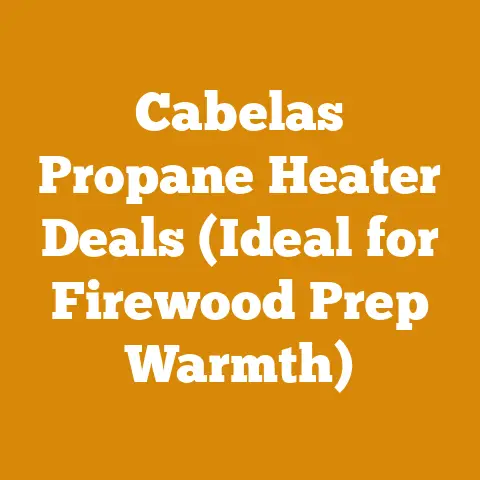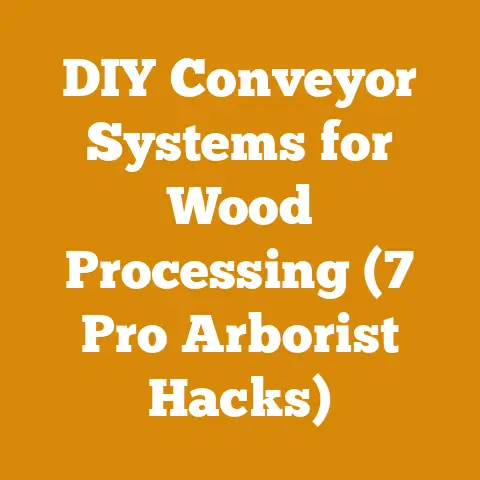Pellet Stove Not Burning Pellets Completely (5 Pro Tips)
Let’s dive in!
Pellet Stove Not Burning Pellets Completely (5 Pro Tips)
Innovation in home heating has brought us a long way from open fireplaces. Pellet stoves, with their efficiency and convenience, are a testament to this progress. But what happens when your pellet stove isn’t performing as it should, leaving you with a hopper full of partially burned or unburned pellets? It’s frustrating, I know, because I’ve been there myself.
I remember the first winter I relied solely on a pellet stove to heat my small cabin in the Adirondacks. The promise of consistent, automated heat was incredibly appealing after years of splitting firewood. However, after a few weeks, I started noticing an unsettling amount of unburned pellets accumulating in the burn pot. The cabin wasn’t as warm as it should be, and my pellet consumption seemed unusually high. This led me down a rabbit hole of troubleshooting, learning everything I could about pellet stove operation, maintenance, and the nuances of pellet quality.
Through that experience, and subsequent years working with other wood heating systems, I’ve gathered a wealth of knowledge about diagnosing and resolving common pellet stove issues. In this article, I’m going to share five pro tips that will help you troubleshoot why your pellet stove isn’t burning pellets completely. These tips are born from hands-on experience, industry best practices, and a healthy dose of trial and error. Let’s get started!
Key Takeaways:
- Poor pellet quality significantly impacts stove performance. Understanding pellet grades and moisture content is crucial.
- Airflow is essential for complete combustion. Cleaning and maintaining your stove’s venting system is paramount.
- Proper stove settings are key. Adjusting the feed rate and air intake can optimize the burn.
- Regular maintenance prevents issues. A clean stove burns more efficiently and reliably.
- Professional help might be necessary. Don’t hesitate to call a technician for complex problems.
1. The Pellet Quality Conundrum: Are You Feeding Your Stove the Right Stuff?
One of the first things I learned about pellet stoves is that not all pellets are created equal. In fact, the quality of your pellets can have a dramatic impact on how efficiently your stove burns. Think of it like this: you wouldn’t put low-octane fuel in a high-performance engine, would you? The same principle applies here.
Understanding Pellet Grades:
Pellets are typically categorized into different grades, usually premium and standard. Premium pellets generally have lower ash content and higher heat output. Standard pellets are often more affordable but may produce more ash and less heat.
- Ash Content: This is a critical factor. High ash content can lead to clinkers (hard, fused ash deposits) that choke the airflow in your burn pot, preventing complete combustion. According to the Pellet Fuels Institute (PFI), premium pellets should have an ash content of less than 1%, while standard pellets can have up to 3%. I’ve seen stoves struggle with pellets that exceed even that, resulting in a smoldering mess.
- BTU Value: British Thermal Units (BTUs) measure the heat output of the pellets. Higher BTU values mean more heat per pellet. Look for pellets with a BTU rating of at least 8,000 BTU/lb.
- Moisture Content: Excessive moisture is a combustion killer. Pellets should have a moisture content of less than 8%. High moisture content not only reduces heat output but also contributes to incomplete burning and creosote buildup in your venting system.
My Experience:
I once bought a large quantity of “bargain” pellets from a new supplier. They were significantly cheaper than my usual brand, and I thought I was getting a great deal. However, after loading them into my stove, I quickly realized my mistake. The stove struggled to maintain temperature, and I was constantly cleaning out the burn pot. The pellets produced an excessive amount of ash, and the glass door of the stove was constantly covered in soot. After doing some research, I discovered that these pellets had a much higher ash and moisture content than advertised. I ended up donating the remaining pellets to a friend who used them in an outdoor smoker (where the lower quality wasn’t as critical). Lesson learned: don’t skimp on pellet quality!
Data-Backed Insights:
A study conducted by the University of Maine found that using premium-grade pellets can increase heating efficiency by as much as 15% compared to standard-grade pellets. This translates to lower fuel consumption and reduced maintenance.
Pro Tip: Always buy pellets from reputable suppliers and check their PFI grade certification. Don’t be afraid to spend a little extra on higher-quality pellets; the improved performance and reduced maintenance will likely offset the cost in the long run.
Actionable Steps:
- Check the pellet bag: Look for the PFI grade certification and information on ash content, BTU value, and moisture content.
- Inspect the pellets: They should be smooth, dry, and uniform in size. Avoid pellets that are crumbling, dusty, or have an off odor.
- Test a small batch: Before committing to a large purchase, buy a bag or two and see how they perform in your stove.
2. The Airflow Imperative: Letting Your Stove Breathe
Airflow is the lifeblood of any combustion process, and pellet stoves are no exception. A restricted airflow can lead to incomplete burning, excessive smoke, and even dangerous carbon monoxide buildup. I can’t stress this enough: proper ventilation is paramount!
Understanding the Ventilation System:
Pellet stoves rely on a complex system of air intakes, exhaust vents, and fans to ensure proper combustion. The intake system draws fresh air into the stove, while the exhaust system removes combustion gases. Any blockage or restriction in this system can disrupt the delicate balance required for efficient burning.
Common Culprits:
- Dirty Venting: This is the most common cause of airflow problems. Over time, creosote and ash can accumulate in the venting system, reducing its diameter and restricting airflow. I recommend cleaning your venting system at least once a year, or more frequently if you burn a lot of pellets.
- Obstructed Air Intakes: Air intakes can become blocked by dust, debris, or even pet hair. Regularly inspect and clean your air intakes to ensure they are free and clear.
- Faulty Combustion Fan: The combustion fan is responsible for drawing air into the burn pot. If the fan is not working properly, it can lead to incomplete burning.
- Burn Pot Buildup: Ash and clinkers can accumulate in the burn pot, restricting airflow and preventing pellets from burning completely.
My Experience:
I once received a call from a friend who was having trouble with his pellet stove. He complained that it was producing a lot of smoke and not generating much heat. After inspecting his stove, I discovered that his venting system was almost completely blocked with creosote. He hadn’t cleaned it in over two years! After a thorough cleaning, the stove ran like new. He was amazed at the difference proper maintenance made.
Data-Backed Insights:
The National Fire Protection Association (NFPA) recommends that pellet stove venting systems be inspected and cleaned at least annually by a qualified professional. Failure to do so can increase the risk of fire and carbon monoxide poisoning.
Pro Tip: Invest in a good quality vent brush and cleaning kit. Cleaning your own venting system is a relatively simple task that can save you money and improve the performance of your stove.
Actionable Steps:
- Inspect your venting system: Look for any signs of blockage or damage.
- Clean your venting system: Use a vent brush to remove creosote and ash.
- Clean your air intakes: Vacuum or wipe down the air intakes to remove dust and debris.
- Inspect your combustion fan: Make sure the fan is running smoothly and not making any unusual noises.
- Clean your burn pot: Remove ash and clinkers regularly.
3. The Setting Sweet Spot: Fine-Tuning Your Stove’s Operation
Even with high-quality pellets and a clean venting system, your pellet stove may still not burn pellets completely if the settings are not properly adjusted. Pellet stoves are sophisticated machines with multiple settings that control the fuel feed rate and air intake. Finding the right balance between these settings is crucial for optimal performance.
Understanding the Settings:
- Feed Rate: This setting controls the amount of pellets that are fed into the burn pot. A higher feed rate means more pellets are burned, resulting in more heat. However, if the feed rate is too high, the stove may not be able to burn the pellets completely, leading to unburned pellets in the burn pot.
- Air Intake: This setting controls the amount of air that is drawn into the burn pot. More air means more oxygen for combustion, resulting in a hotter and cleaner burn. However, if the air intake is too high, it can cool down the fire and prevent complete combustion.
Finding the Balance:
The ideal settings for your pellet stove will depend on a number of factors, including the quality of your pellets, the size of your room, and the outdoor temperature. It may take some experimentation to find the sweet spot that works best for your particular situation.
My Experience:
When I first started using my pellet stove, I simply set it to the highest setting and assumed that would give me the most heat. However, I quickly realized that this was not the case. The stove was producing a lot of smoke and leaving a significant amount of unburned pellets in the burn pot. After reading the owner’s manual and experimenting with different settings, I found that a lower feed rate and a slightly higher air intake resulted in a much cleaner and more efficient burn.
Data-Backed Insights:
A study by the Biomass Energy Resource Center (BERC) found that properly adjusting the settings on a pellet stove can improve heating efficiency by as much as 20%.
Pro Tip: Consult your owner’s manual for specific recommendations on setting adjustments for your particular model. Start with the recommended settings and then make small adjustments as needed to optimize performance.
Actionable Steps:
- Consult your owner’s manual: Familiarize yourself with the different settings on your stove.
- Start with the recommended settings: Use the settings recommended in the owner’s manual as a starting point.
- Make small adjustments: Adjust the feed rate and air intake in small increments and observe the results.
- Monitor the burn: Pay attention to the color of the flame, the amount of smoke produced, and the amount of unburned pellets in the burn pot.
- Adjust as needed: Continue to adjust the settings until you achieve a clean and efficient burn.
4. The Maintenance Mandate: Keeping Your Stove in Tip-Top Shape
Regular maintenance is essential for keeping your pellet stove running efficiently and reliably. Neglecting maintenance can lead to a variety of problems, including incomplete burning, reduced heat output, and even safety hazards. Think of it like your car – you wouldn’t skip oil changes and expect it to run smoothly, would you?
Essential Maintenance Tasks:
- Daily Cleaning: Empty the ash pan regularly to prevent ash buildup.
- Weekly Cleaning: Clean the burn pot and heat exchanger tubes to remove ash and creosote.
- Monthly Cleaning: Inspect and clean the venting system, air intakes, and combustion fan.
- Annual Inspection: Have your stove inspected by a qualified technician to identify any potential problems.
My Experience:
I once neglected to clean my pellet stove for several weeks, and the ash pan became completely full. The stove started producing a lot of smoke and the heat output decreased significantly. After cleaning the ash pan and burn pot, the stove ran much better. This experience taught me the importance of regular maintenance.
Data-Backed Insights:
The U.S. Environmental Protection Agency (EPA) recommends that pellet stoves be inspected and cleaned at least annually by a qualified technician.
Pro Tip: Create a maintenance schedule and stick to it. Regular maintenance will not only improve the performance of your stove but also extend its lifespan.
Actionable Steps:
The Professional Intervention: When to Call in the Experts
Sometimes, despite your best efforts, your pellet stove may still not be burning pellets completely. In these cases, it may be necessary to call in a qualified technician to diagnose and repair the problem. Don’t hesitate to seek professional help if you are unsure about what to do.
Signs You Need Professional Help:
- Unusual Noises: Grinding, squealing, or rattling noises can indicate a mechanical problem.
- Excessive Smoke: Excessive smoke can indicate a problem with the venting system or combustion fan.
- Carbon Monoxide Alarm: A carbon monoxide alarm indicates a serious safety hazard.
- Persistent Incomplete Burning: If you have tried all of the troubleshooting steps outlined above and your stove is still not burning pellets completely, it is time to call a professional.
My Experience:
I once had a problem with my pellet stove that I couldn’t figure out. The stove was producing a lot of smoke and the combustion fan was making a strange noise. After trying everything I could think of, I finally called a qualified technician. He quickly diagnosed the problem as a faulty combustion fan motor. He replaced the motor, and the stove ran like new.
Data-Backed Insights:
According to the Hearth, Patio & Barbecue Association (HPBA), it is important to hire a certified technician for any major repairs or maintenance tasks on your pellet stove.
Pro Tip: Look for a technician who is certified by the National Fireplace Institute (NFI) or the HPBA. These certifications indicate that the technician has the knowledge and skills necessary to properly service your pellet stove.
Actionable Steps:
- Research local technicians: Look for qualified technicians in your area.
- Check certifications: Make sure the technician is certified by the NFI or the HPBA.
- Get multiple quotes: Compare prices from different technicians.
- Ask for references: Check the technician’s references.
- Schedule an appointment: Schedule an appointment for the technician to inspect your stove.
In Conclusion:
Dealing with a pellet stove that isn’t burning pellets completely can be frustrating, but by following these five pro tips, you can significantly improve your stove’s performance and efficiency. Remember to prioritize pellet quality, ensure proper airflow, fine-tune your stove’s settings, maintain a regular cleaning schedule, and don’t hesitate to seek professional help when needed.
My journey with pellet stoves has taught me that a little knowledge and proactive maintenance can go a long way. By taking the time to understand your stove and address any issues promptly, you can enjoy a warm, efficient, and hassle-free heating experience all winter long. Now, go forth and conquer those pellet stove problems!






